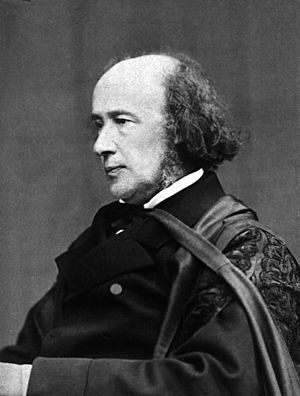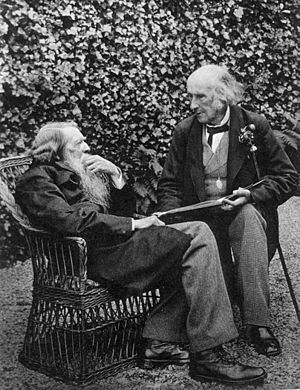Henry Acland facts for kids
Sir Henry Wentworth Dyke Acland (born August 23, 1815 – died October 16, 1900) was an important English doctor and teacher. He helped change how science and medicine were taught at Oxford University.
Contents
Early Life and Education
Henry Acland was born in Killerton, Exeter. He was the fourth son of Sir Thomas Acland. Henry went to school at Harrow and then studied at Christ Church, Oxford.
In 1840, he became a Fellow at All Souls College, Oxford. After this, he went on to study medicine in London and Edinburgh.
A Career in Medicine and Education
Becoming a Professor
Henry Acland returned to Oxford in 1845. He was appointed as a reader in anatomy at Christ Church. This meant he taught about the human body. In 1847, he became a member of the Royal Society. This is a very old and respected group for scientists.
In 1851, he became the Radcliffe librarian and a doctor at the Radcliffe Infirmary. Seven years later, he became the Regius Professor of Medicine. This was a very important job, and he kept it until 1894. He also helped look after the university's art galleries and the famous Bodleian Library.
Helping the Medical World
From 1858 to 1887, Henry Acland represented Oxford University on the General Medical Council. This council helps set rules for doctors. He even became its president from 1874 to 1887.
In 1860, he traveled with the Prince of Wales (who later became King Edward VII). He was the Prince's doctor during a trip to Canada and the United States.
Honors and Achievements
Henry Acland received several honors for his work. He was made a Companion of the Order of the Bath (CB) in 1883. The next year, he was promoted to a Knight Commander (KCB). In 1890, he was given the title of baronet. He passed away ten years later in Oxford.
Changing Science and Art at Oxford
Improving Medical Education
Henry Acland played a big part in making the Oxford medical school better. He also helped bring the study of natural science into the university. He started collecting models and samples to teach about the human body.
He was key to setting up the Oxford University Museum, which opened in 1861. This museum was created to encourage the study of science, especially for medicine. His friend, John Ruskin, said that Acland saw medicine as a very important subject.
Connecting Science and Humanities
Even though he loved science, Henry Acland also valued classical studies. He made sure that science at Oxford did not become too separate from other subjects like history and literature.
With Dean Liddell, he also changed how art and archaeology were studied. Thanks to their efforts, these subjects became much more popular at the university.
Public Health Efforts
Henry Acland was also very interested in public health. He worked on a special group that looked into health laws in England and Wales in 1869. He wrote about a cholera outbreak in Oxford in 1854. He also wrote many small books about health and hygiene.
In 1873, he was chosen as a member of the American Philosophical Society. This is a famous group that promotes knowledge in many fields.
Family Life
Henry Acland married Sarah Cotton on July 14, 1846. They had seven sons and one daughter:
- Admiral Sir William Alison Dyke Acland, 2nd Baronet (1847–1924)
- Sarah Angelina Acland (1849–1930)
- Henry Dyke Acland (1850–1936)
- Theodore Dyke Acland (1851–1931)
- Herbert Dyke Acland (1855–1877)
- Sir Reginald Brodie Dyke Acland (1856–1924)
- Francis Edward Dyke Acland (1857–1943)
- Alfred Dyke Acland (1858–1937)
The old Acland Hospital in Oxford was built in memory of Henry Acland's wife, Sarah.
Their daughter, Sarah Angelina Acland, became a pioneer in color photography. Some of her early color photographs are kept at the Museum of the History of Science in Oxford.




